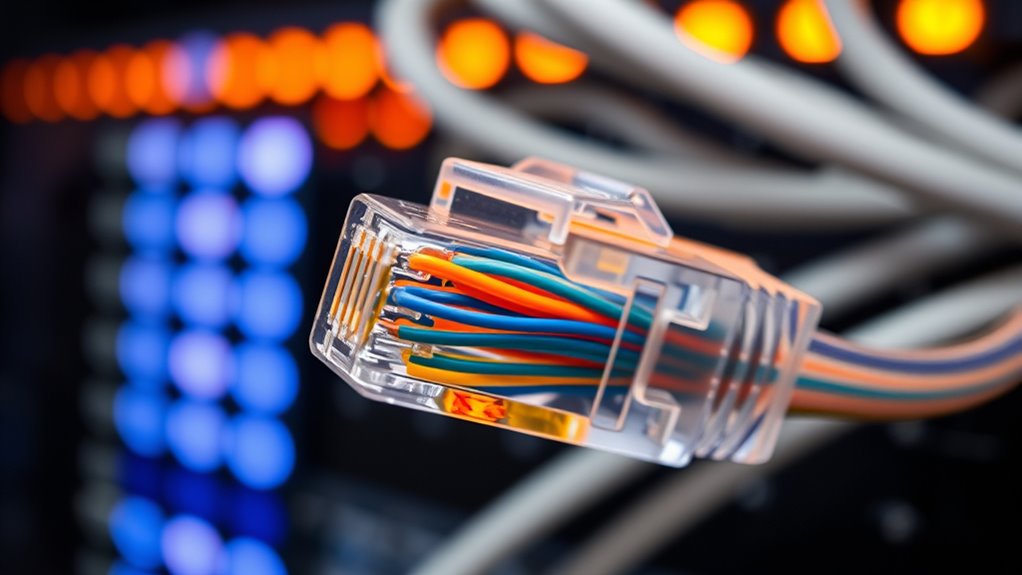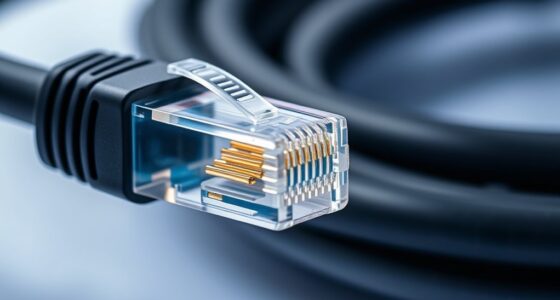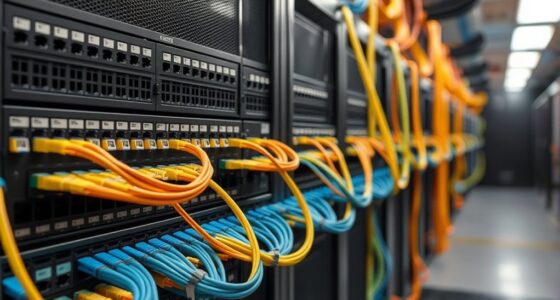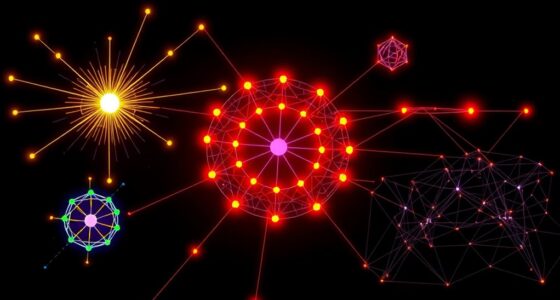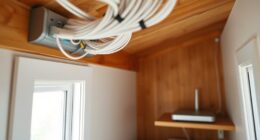In the OSI Model, the physical layer is responsible for transmitting raw data over cables. It defines how signals travel through different types like fiber optic or twisted pair cables. Fiber optics use pulses of light for long-distance, high-speed transmission, while twisted pair cables work well for shorter, local connections. Choosing the right cable depends on your environment and needs. Keep exploring to understand how these cables support and optimize your network.
Key Takeaways
- The physical layer is the first layer of the OSI Model, responsible for transmitting raw bitstreams over cables.
- It defines the electrical, mechanical, and procedural aspects of physical cable connections.
- Fiber optic and twisted pair cables serve as primary mediums for data transmission at this layer.
- The choice of cable impacts signal quality, distance, interference, and overall network performance.
- Proper understanding of physical layer cables ensures effective network design and reliable communication.
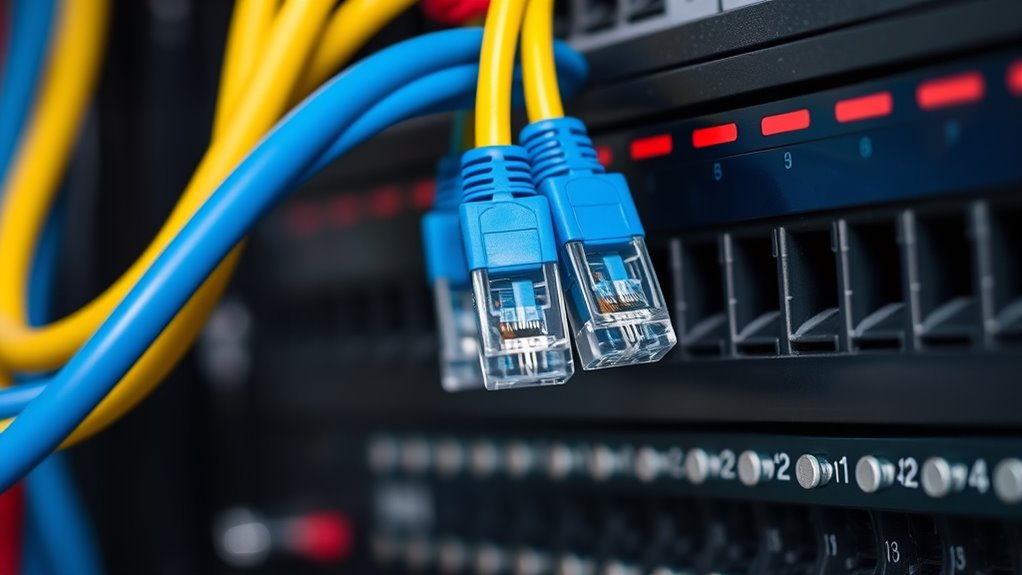
Have you ever wondered how devices communicate over a network? It all starts with the physical layer of the OSI Model, which is responsible for transmitting raw data between devices. This layer uses various types of cables to carry signals, each suited for different environments and needs. The most common types you’ll encounter are fiber optic cables and twisted pair cables, both essential for establishing reliable connections.
Fiber optic cables are a marvel of modern networking technology. They use thin strands of glass or plastic to transmit data as pulses of light. Because of this, they can carry data over much longer distances without degradation and provide extremely high bandwidths. If you need a network that spans across city blocks or even continents, fiber optics are the best choice. They’re immune to electromagnetic interference, making them ideal for environments with lots of electrical noise. Installing fiber optic cables might be more complex and costly initially, but their performance benefits clear any doubts about their value for high-speed, long-distance communication.
Fiber optic cables transmit data as pulses of light over long distances with high bandwidth and immunity to interference.
On the other hand, twisted pair cables are more common in everyday networking setups. They consist of pairs of insulated copper wires twisted around each other, which helps reduce electromagnetic interference and crosstalk. You’ll find twisted pair cables in most homes and offices, connecting computers, routers, and switches. They’re easier to install and more affordable than fiber optics, making them perfect for local area networks (LANs). While they don’t support the same high data rates or long-distance transmission as fiber optic cables, twisted pair cables still deliver reliable performance for most standard networking needs.
Both fiber optic and twisted pair cables serve the same fundamental purpose: transmitting data at the physical level. However, their differences influence where and how you use them. Fiber optics excel in high-speed, long-distance, and interference-prone environments. Twisted pair cables are more practical for short-distance, cost-sensitive setups within buildings. When designing your network, understanding these distinctions helps you choose the right cable type to ensure your devices communicate effectively. Remember, the physical layer is the foundation of your entire network, and selecting the proper cable ensures stable, efficient data transmission. Whether you’re setting up a small office or a large enterprise network, knowing the role of fiber optic cables and twisted pair cables allows you to optimize your infrastructure for speed, reliability, and cost-effectiveness.
Additionally, advancements in cable technology continue to improve data transmission capabilities and reduce costs, making it easier for businesses and individuals to implement robust networks.
Frequently Asked Questions
How Do Physical Layer Cables Impact Network Security?
Physical layer cables impact your network security by introducing wiretap vulnerabilities, where attackers can intercept data transmitted through unprotected cables. To mitigate this, you should consider cable encryption, which protects data from eavesdropping. Ensuring proper cable management and physical security also helps prevent unauthorized access. By addressing these factors, you reduce the risks associated with physical layer vulnerabilities, safeguarding your network from potential attacks.
What Are the Differences Between Fiber Optic and Copper Cables?
You’ll notice fiber optic cables offer advantages like higher bandwidth, faster speeds, and longer distance transmission compared to copper cables. Copper cable types include twisted pair and coaxial, which are generally cheaper but less capable of supporting high data rates over long distances. Fiber optics are immune to electromagnetic interference, making them ideal for secure, high-performance networks, whereas copper cables are more susceptible to interference and limited in range.
Can Physical Cables Affect Network Speed and Performance?
Yes, physical cables can substantially affect your network speed and performance. Different cable types, like fiber optic or copper, transmit data at varying speeds. Signal interference from external sources, such as electromagnetic interference, can cause data loss or delays. Choosing the right cable type and ensuring proper shielding helps minimize interference, ensuring your network runs smoothly and efficiently without bottlenecks or slowdowns.
How Are Physical Layer Cables Tested and Maintained?
Think of physical layer cables as the veins of your network, carrying essential data. You test these cables with specialized tools like cable testers to check continuity, signal strength, and interference. Regular maintenance procedures include inspecting for physical damage, cleaning connectors, and replacing faulty cables promptly. These steps guarantee your network stays healthy and performs at its best, preventing future issues and keeping your data flowing smoothly like a well-oiled machine.
What Are Common Issues Caused by Faulty Physical Cables?
Faulty physical cables often cause issues like intermittent connections, slow data transfer, or complete network failure. You might notice problems from worn or damaged cable insulation, which exposes wires to damage or interference. Connector corrosion can also disrupt signals, leading to poor connectivity. Regularly inspecting cables for cracks, cuts, or corrosion helps prevent these issues and guarantees your network remains reliable and efficient.
Conclusion
Understanding how physical layer cables fit into the OSI model shows their essential role in network communication. Many believe that higher layers handle all data processes, but without reliable cables like Ethernet or fiber optics, your network can’t function. This proves that solid physical connections are the backbone of effective data transfer. In reality, the physical layer’s reliability directly impacts your entire network’s performance—so, investing in quality cables truly makes a difference.
